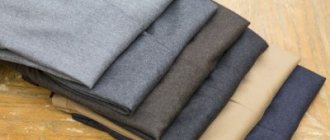Most backpacks are made from nylon. They can be safely washed in a washing machine, except for those backpacks that have a waterproof layer or impregnation. By feeling the material from which your hiking bag is made, you can determine the presence of such a layer. If one side (usually the inside) is smooth and the other is not, this means your backpack has a waterproof layer. Backpacks with a waterproof coating should be hand washed following the instructions below and should not be dried using heat.
Where to begin?
Start by completely emptying your backpack. Feel all the corners of the pockets and compartments - pull out everything you find in them. If there is a lot of dust and debris in your pockets, vacuum them. Look inside (in the main compartment or in the pockets) for a label with washing instructions for your backpack.
How to wash a backpack in the washing machine
- Unzip all zippers on the backpack, as they may be damaged if washed closed.
- Check that all buckles and straps are secure.
- If you have a top-loading washing machine, place the backpack in a laundry bag or pillowcase - this will keep the straps from getting tangled.
- If your backpacking bag has an internal frame, remove it. The frame may become bent or damaged in the washing machine and may tear the fabric.
- Inspect the backpack thoroughly, checking for any stains, tears or fraying of the fabric. If you find a frayed area, use the backpack's hand-washing instructions as washing the bag will cause further wear on the damaged area.
- Remove or pre-treat any dirty stains.
- Wash the backpack using cold water and the delicate program. If the backpack is very large, take it to the laundromat (they have large washing machines) or hand wash it in the bathtub.
- Hang your backpack over the bathtub to allow water to run off so it can dry.
Proper drying
Drying is carried out in a vertical position. Turn the washed backpack inside out and secure it to coat hangers and place it in an area with good air flow. When the lining is dry, turn the product right side out and leave to dry.
Some types of textile backpacks can be ironed, a label inside will tell you this. Be sure to follow the recommended temperature conditions and iron through a cotton cloth to avoid leaving shiny marks on the surface.
Backpacks made of leatherette, genuine leather, and impregnated materials are prohibited from being dried on the fireplace.
How to wash a backpack by hand
- Fill a bucket or tub with enough water to completely cover your backpack.
- Add laundry detergent to the water and stir vigorously by hand.
- If your backpack has an internal frame, it's best to pull it out. Although hand washing is a fairly gentle process and the frame tubes will not tear the fabric, the metal can begin to rust from excessive exposure to water.
- Place the backpack in the water and gently swirl it around to wet all sides.
- If there are any particularly dirty areas, scrub them with an old toothbrush or clothes brush.
- Rinse your backpack thoroughly in the shower.
- Hang your backpack over the bathtub to allow water to run off so it can dry.
How to wash a backpack in the dishwasher
Although the dishwasher can be used to wash shoes, baseball caps, and other household items, it is not recommended to wash your backpack in the dishwasher. The temperature in a dishwasher is much higher than in a washing machine - it can damage the material or cause paint to fade. Additionally, dishwashers have rotating spray arms in the work compartment, which can get caught on the straps, damaging both the backpack and the dishwasher. If you still want to machine wash your backpack, place it in a pillowcase or loose laundry bag. If your camp bag can fit on the top shelf, put it there. Use a non-bleach detergent and remove the backpack before the drying cycle begins. Hang your backpack over the bathtub to allow water to run off so it can dry.
Contraindications for care
In order for the fabric to retain its visual appeal and strength for a long time, it is prohibited:
boil or wash things at temperatures above 40. High temperatures destroy the structure of the fibers and deform the fabric;- treat products with harsh detergents containing chlorine, various bleaches or stain removers;
- twist by hand or use high spin speeds when machine washing;
- dry in the sun, hot radiators or other heat sources.
How to wash a polyester backpack
Polyester is a very versatile fabric that is generally strong and durable, regardless of whether it is thick or not. If your backpack does not have any special embellishments such as studs, studs or leather trim, it can be safely machine washed using cold water on the delicate cycle. However, polyester is also known for absorbing and storing body odors, so give your backpacking bag a sniff and, if necessary, treat the back and straps using the "how to wash backpack straps" method below.
Removing stains
As a result of long-term use, stains and stains appear on the fabric. Before you wash a leather backpack or fabric item yourself, you need to remove all dirt. To do this, you should choose a stain remover. They are all divided into 3 types:
- Sorbents - this option is suitable for products made from natural materials. When they come into contact with contaminants, active elements destroy them from the inside. In this case, the structure of the material is not disturbed.
- Solvents – intended for synthetic fabrics. They contain alcohol, so they are effective against grease and ink.
- Oxygen-containing stain removers - suitable for removing stains on colored materials.
How to wash backpack straps
The straps and straps of a backpack collect the most sweat and dirt because they are in constant contact with your hands. They can be washed separately periodically, which will reduce the overall wear and tear on the backpack fabric and increase its service life.
- Mix a small amount of dishwashing liquid or shampoo with water, then stir the water vigorously to create a lather.
- Using a toothbrush or clothing brush, apply the resulting foam to the belts and scrub thoroughly.
- Rinse the belts under the tap, or wipe them with a little water. If your belts have filling inside, try not to get them completely wet, otherwise they will take much longer to dry.
- To help the straps dry quickly, hang the backpack outdoors.
Which items should not be machine washed?
Logically, any fabric backpack can be loaded into the washing machine. However, everything is not so simple. Before washing your backpack, it is recommended to pay attention to some factors:
The design of a school bag, as a rule, includes a hard insert. It is covered with fabric and is not always available. If it is made of plastic, then there is no need to worry - you can safely wash the backpack. If it is a piece of plywood or chipboard, then after washing the insert will get wet and the backpack will lose its shape.
The quality of the fittings also plays an important role. Often buttons, locks and other parts rust, and this rust spreads to the fabric, so you can machine wash your backpack only if the fittings are made of stainless steel. Fabric impregnated with a special water-repellent composition will gradually lose its properties after several washes. Such products can be cleaned with dry compounds or foam, but they cannot be soaked or washed. Any backpack cannot be boiled or washed in hot water. No matter how dense and durable the fabric is, such manipulations can negatively affect its quality and ruin the shape of the product.
Where to start washing?
Start by completely emptying your backpack. Feel all the corners of the pockets and compartments - pull out everything you find in them. If there is a lot of dust and debris in your pockets, vacuum them. Look inside (in the main compartment or in the pockets) for a label with washing instructions for your backpack.
How to wash a backpack in the washing machine
- Unzip all zippers on the backpack, as they may be damaged if washed closed.
- Check that all buckles and straps are secure.
- If you have a top-loading washing machine, place the backpack in a laundry bag or pillowcase - this will keep the straps from getting tangled.
- If your backpacking bag has an internal frame, remove it. The frame may become bent or damaged in the washing machine and may tear the fabric.
- Inspect the backpack thoroughly, checking for any stains, tears or fraying of the fabric. If you find a frayed area, use the backpack's hand-washing instructions as washing the bag will cause further wear on the damaged area.
- Remove or pre-treat any dirty stains.
- Wash the backpack using cold water and the delicate program. If the backpack is very large, take it to the laundromat (they have large washing machines) or hand wash it in the bathtub.
- Hang your backpack over the bathtub to allow water to run off so it can dry.
How to wash a backpack by hand
- Fill a bucket or tub with enough water to completely cover your backpack.
- Add laundry detergent to the water and stir vigorously by hand.
- If your backpack has an internal frame, it's best to pull it out. Although hand washing is a fairly gentle process and the frame tubes will not tear the fabric, the metal can begin to rust from excessive exposure to water.
- Place the backpack in the water and gently swirl it around to wet all sides.
- If there are any particularly dirty areas, scrub them with an old toothbrush or clothes brush.
- Rinse your backpack thoroughly in the shower.
- Hang your backpack over the bathtub to allow water to run off so it can dry.
Attention!
For washing, choose a liquid detergent. It will be effective at low temperatures and will wash out of the fabric well. How to wash a backpack in the dishwasher
Although the dishwasher can be used to wash shoes, baseball caps, and other household items, it is not recommended to wash your backpack in the dishwasher. The temperature in a dishwasher is much higher than in a washing machine - it can damage the material or cause paint to fade. Additionally, dishwashers have rotating spray arms in the work compartment, which can get caught on the straps, damaging both the backpack and the dishwasher. If you still want to machine wash your backpack, place it in a pillowcase or loose laundry bag. If your camp bag can fit on the top shelf, put it there. Use a non-bleach detergent and remove the backpack before the drying cycle begins. Hang your backpack over the bathtub to allow water to run off so it can dry.
How to wash a polyester backpack
Polyester is a very versatile fabric that is generally strong and durable, regardless of whether it is thick or not. If your backpack does not have any special embellishments such as studs, studs or leather trim, it can be safely machine washed using cold water on the delicate cycle. However, polyester is also known for absorbing and storing body odors, so give your backpacking bag a sniff and, if necessary, treat the back and straps using the "how to wash backpack straps" method below.
How to wash a canvas backpack
Tarpaulin is a durable material that can withstand washing in the washing machine. It can even withstand hot water, although this may cause the color to fade. Canvas backpacks can even be machine-wrung at low speeds and then hung out to dry.
How to wash a cotton backpack
It is important to wash a cotton backpack in cold water, as cotton fabric is prone to shrinkage. Even if the label of your backpack says that it can withstand hot or warm water, it would be better to wash it in cold. A cotton backpack can be machine-wrung at low speeds and then hung out to dry.
How to wash a hemp backpack
Hemp fabric can easily be machine washed in warm water. It can be washed often, which only makes it softer. A backpack made of hemp takes longer to dry than one made of synthetic fabric, but it does not require any special treatment and can be wrung out in the machine at low speeds.
How to wash a denim backpack
Jeans can fade, so if you wash your backpack in a pillowcase, be sure to use one that you don’t mind getting damaged. Denim takes longer to dry than most other fabrics, but you can spin a denim backpack in the washing machine on low to speed up drying time. It is better to dry such a camping bag in the fresh air; denim fabric may shrink in the dryer.
How to wash backpack straps
The straps and straps of a backpack collect the most sweat and dirt because they are in constant contact with your hands. They can be washed separately periodically, which will reduce the overall wear and tear on the backpack fabric and increase its service life.
Mix a small amount of dishwashing liquid or shampoo with water, then stir the water vigorously to create a lather.
Using a toothbrush or clothing brush, apply the resulting foam to the belts and scrub thoroughly.
Rinse the belts under the tap, or wipe them with a little water. If your belts have filling inside, try not to get them completely wet, otherwise they will take much longer to dry.
To help the straps dry quickly, hang the backpack outdoors.
Attention! If the zipper becomes stubborn, apply a little WD-40 to a piece of plastic and then use a rag or brush to lubricate the zipper - this will prevent the grease from getting onto the surrounding fabric.
How to wash a backpack with leather parts
Unless otherwise stated on the care label, a backpack with leather trim or leather parts should not be completely washed to avoid getting the leather wet. Areas of fabric with dirty stains are treated separately.
Mix a small amount of dishwashing liquid or laundry detergent with water, then stir the water vigorously to create a suds.
Using a toothbrush or clothing brush, apply the resulting foam to dirty stains.
Rub the brush thoroughly into the treated areas of the backpack.
Rinse the cleaned area with a sponge and clean water.
Dry the fabric of the backpack and then let it dry in the fresh air.
Wash your leather parts by following the instructions in our How to Clean Genuine Leather guide.
How to wash a backpack with rivets
The external finishing of the backpack with metal studs and rivets gives it a unique look, but at the same time adds special care requirements. It is best to avoid getting water on metal parts as they may rust. Therefore, such backpacks cannot be washed completely; only dirty spots on them are cleaned.
- Mix a small amount of dishwashing liquid or laundry detergent with water, then stir the water vigorously to create a suds.
- Using a toothbrush or clothing brush, apply the resulting foam to dirty stains.
- Give the dirty areas of the backpack a good scrub with the brush.
- Rinse the cleaned area with a sponge and clean water.
- Dry the backpack fabric.
- Gently polish the studs and rivets with a soft, dry cloth.
Attention! If your backpack smells bad and you can't wash it, put a pack of cheap coffee beans inside. It neutralizes foreign odors and adds freshness. You should leave the coffee overnight and you can remove it in the morning, but we recommend leaving it longer until you get to the nearest laundromat.
How to properly dry a backpack?
It is best to let the material dry naturally. Pockets should not be closed immediately after washing, otherwise they will not dry well. If the weather is good outside, the backpack can be hung neatly on ropes on the balcony. In case of rain or in winter, it is not recommended to put it in the dryer; it is better to let the material dry in the room.
It is important to ensure that the backpack is dry before using it or storing it in a closet. If some places remain even slightly damp, mold and an unpleasant odor will form there over time, which will not be easy to get rid of.
How to remove mold from a backpack
Take your backpack outside.
Clean the mold with a disposable wipe, being careful not to spread its spores to clean areas.
Wipe the moldy area of the backpack with rubbing alcohol.
Rinse the treated area with a sponge and clean water.
Wipe the cleaned area dry with disposable wipes.
Hang your backpack to dry in the sun. Sunlight will help kill any remaining mold spores.
How to remove bedbugs and other pests from your backpack
If you suspect your backpack has bedbugs, lice, or other small pests, place it in a plastic trash bag. Tie the top of the bag into a knot. Leave the bag tied for a couple of weeks, or leave it in a hot place, such as a closed car in the sun in the summer, for a couple of days. Once the insects are killed, wash the backpack according to the instructions above.
How to keep your briefcase clean for a long time
Even if the backpack is machine washable, it is not always possible to do this regularly. In addition, too frequent washing can lead to premature wear of the material. In order to keep your portfolio clean for a long time, you need to follow simple rules.
Many people have a very bad habit of putting garbage in their pockets. You can't do this. You need to train yourself to immediately throw away even a piece of candy in the trash.
It is not recommended to place the briefcase on the floor, as it will quickly become covered with dust. In addition, clothes can get dirty from a dirty bottom.
Before putting anything inside your backpack, you need to check that the item is clean. For example, if it is shoes, you first need to wrap it in a bag.
If the material gets dirty, you should immediately try to get rid of the stain with simple damp wipes.
Now there will be no more questions about how to wash a school backpack or travel backpack. By following the simple rules presented, the material will not be damaged and the color of the product will not fade.
Attention! To protect your backpack from getting wet in the rain, place it in a plastic trash bag and cut holes in it for the straps and pockets of the backpack.
How to wash a backpack with leather parts
Unless otherwise stated on the care label, a backpack with leather trim or leather parts should not be completely washed to avoid getting the leather wet. Areas of fabric with dirty stains are treated separately.
- Mix a small amount of dishwashing liquid or laundry detergent with water, then stir the water vigorously to create a suds.
- Using a toothbrush or clothing brush, apply the resulting foam to dirty stains.
- Rub the brush thoroughly into the treated areas of the backpack.
- Rinse the cleaned area with a sponge and clean water.
- Dry the fabric of the backpack and then let it dry in the fresh air.
- Wash your leather parts by following the instructions in our How to Clean Genuine Leather guide.
Detergents
The choice of product depends entirely on the material of the backpack.
So, for denim, textile and backpacks made of hemp fabric, it is better to use liquid washing powders. It is better to wash tourist clothes with products for membranes and sportswear:
- Salton Sport shampoo. The liquid product allows you to carefully and effectively wash products with various combinations of materials. Suitable for viscose, microphase, elastane and stretch. Preserves the top moisture-repellent layer and the brightness of colors;
- Bionicdry for sports and membrane clothing. The manufacturer calls the main advantage of the product the careful treatment of impregnated fabrics. In addition, the liquid powder does not clog textile micropores and has antimicrobial properties. It has a fairly noticeable aroma that dissipates after a few days;
- NIKWAX Tech Wach. A universal soldier in your cleaning arsenal. It can be used to wash backpacks, awnings, tents, cases and covers made from fabrics such as Gore-Tex, Permatex and Sympa Tex. Not only removes all types of dirt, but also restores the water-repellent barrier of textiles.
Not all backpacks are washable. Manual cleaning is recommended for models made of natural and artificial leather, with embroidery, rhinestone details and designs made using the painting method, as well as tourist ones with a permanent wire frame.
How to wash a backpack with rivets
The external finishing of the backpack with metal studs and rivets gives it a unique look, but at the same time adds special care requirements. It is best to avoid getting water on metal parts as they may rust. Therefore, such backpacks cannot be washed completely; only dirty spots on them are cleaned.
- Mix a small amount of dishwashing liquid or laundry detergent with water, then stir the water vigorously to create a suds.
- Using a toothbrush or clothing brush, apply the resulting foam to dirty stains.
- Give the dirty areas of the backpack a good scrub with the brush.
- Rinse the cleaned area with a sponge and clean water.
- Dry the backpack fabric.
- Gently polish the studs and rivets with a soft, dry cloth.
Features of the material
Polyester is one of the most popular synthetic materials. The fabric is created by weaving the main and transverse threads. Externally, polyester resembles wool, but its characteristics are very similar to cotton.
Polyester synthetic fabric is different:
long service life - not subject to abrasion, mechanical stress, stretching;- resistance to the absorption of dirt and odors - the special structure of the surface of the fibers does not allow dirt to penetrate and accumulate inside the fabric;
- low creasing - fabric fibers are practically not deformed during washing and drying. Quickly release moisture, forming a smooth surface;
- color fastness - does not fade, tolerates repeated washing, does not fade when exposed to sunlight;
- moisture, wind and cold resistance - the material does not get wet and retains heat well;
- ease of care - if washing recommendations are followed correctly, items made of polyester retain their beautiful appearance for a long time;
- immunity to the effects of aggressive chemicals, the development of bacteria and microorganisms.











